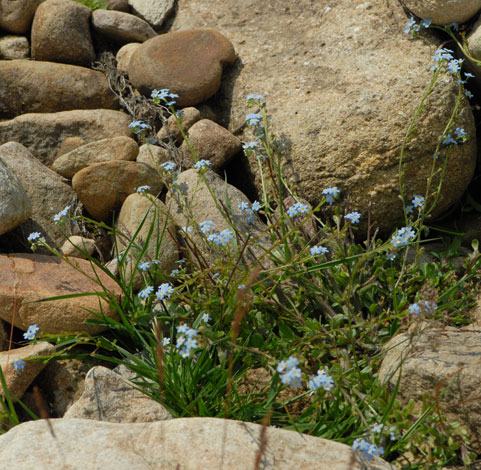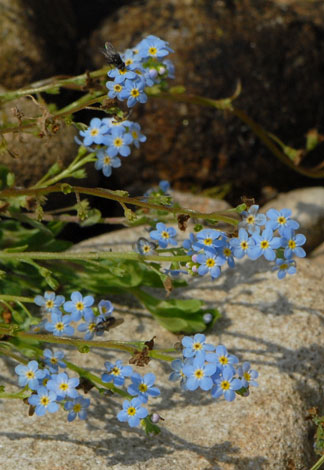Myosotis x bollandica Hybrid Forget-me-not RRR DD N


The British flora is one of the most studied in the world so it is a special day when a new plant is discovered. For some time Lancashire botanist Peter Jepson had noticed something odd about the abundant Forget-me-not populations in the Trough of Bowland in that some appeared to be neither the locally common Myosotis secunda (Creeping Forget-me-not) nor the nationally rarer Myosotis stolonifera (Pale Forget-me-not) but something in between. The plants also appeared to be sterile with empty seed cases and had patent hairs below (like M. secunda) but adpressed hairs on the flowering stems (like both). These characters and the fact that the length of the calyx teeth is part way between the two suggested a hybrid between these two parent Forget-me-nots. However a hybrid between these particular Myosotis species was not only unknown in the British Isles but unknown to Botanical science.
Morphological indications these days are the equivalent of circumstantial evidence - indicative but not conclusive so Peter with the aid of other botanical colleagues set about confirming the hybridity of this plant by chromosome counting. The chromosome numbers in Myosotis stolonifera were known to be 2n=24 while for Myosotis secunda 2n=48. The odd looking Trough of Bowland Forget-me-not had 2n=36 -just as would be expected if it was a hybrid between M. secunda and M. stolonifera. The announcement of this new addition to the World Flora was made by P. Jepson, D. Welch and J.P.Bailey in 2012 in the peer reviewed New Journal of Botany Volume 2 number 1 pp 2 - 8.
Since then other claims have been made by people who were now eagerly looking for such hybrids in places where both parents grew. Some with exactly the same characters as those in the Trough of Bowland have been found in Yorkshire for example. However intermediate characters and sterility are not really enough to say with absolute confidence that a population is definitely this hybrid: the chromosome count must be done as well and up to now only those from this, the type location, have been confirmed by proper scientific study.
The hybrid name recognises the location where the new hybrid was first found: The Trough of Bowland. Perhaps we might have expected the name allocated to this new hybrid to be spelled Myosotis x bowlandica. However some locals still pronounce the name more like Bolland than Bowland and it has been written exactly as Bolland older documents. The area is really the Trough of Bolland in proper Lancastrian.
Come to think of it Bowland does sound like Bolland pronounced by a BBC radio news reader in a 1950s London studio for the Home Service.
Langden valley, Trough of Bowland, Lancashire 18th July 2013
Added on 18th July 2013






